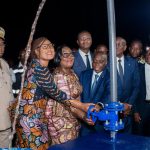The Fourmile project in Nevada is cementing its position as one of the century’s greatest gold discoveries, updated studies by 100%-owner Barrick show. Backed by ongoing 2025 evaluation results1 and the 2024 mineral resource, the new preliminary economic assessment (PEA) underscores Fourmile’s rare combination of grade, scale and exploration upside, confirming its potential to become one of the world’s leading gold producers.
“Fourmile is emerging as a multi-generational project,” says Barrick President and Chief Executive Mark Bristow. “With the ongoing exploration drilling results, we expect to double the resource by the end of this year2 and, even more excitingly, we are continuing to define significant high-grade orebody extensions underpinning the current exploration upside estimate of 32-34Mt @ 15 – 16g/t2 outside of our current 2024 mineral resource. As a result, Fourmile is rapidly competing to be the largest and highest-grade gold discovery this century.”2,3
Speaking today at the Mining Forum Americas in Colorado Springs, Bristow said the updated PEA pointed to the potential for Fourmile to rank among the top 10 gold producers globally, with industry-leading operating cash flows.3 “Very few projects anywhere in the world today can offer this combination of grade, scale and cash flow. Fourmile is one of those rare discoveries that has the potential to reset the industry cost curve.”3
Barrick’s studies are progressing well and continue to confirm the attributes that make this orebody so valuable, namely the grade, significant tonnage and large-scale stoping fronts.3. All of these point to low-cost, long-life production1,2 which has all the hallmarks of a potential Tier One asset4 in the making.
“One characteristic of the Fourmile orebody that makes it even more compelling is the geometallurgy. Unlike Goldrush, which is double refractory, indications are that a significant portion of Fourmile’s mineralization will be single refractory. This means that it can be processed more flexibly and at a lower cost across Nevada Gold Mines’ existing facilities. When combined with the unique positioning of Fourmile, within the greater Carlin-Cortez complexes, this offers a globally unique value proposition with potential to achieve world-class annual cash flows at a very low capital intensity.3 Finding gold at these grades anywhere is exceptional but to do so at this scale adjacent to multiple existing processing facilities is truly remarkable,” said Bristow.
Mineral Resource Management and Evaluation Executive Simon Bottoms said Barrick had updated its previously disclosed PEA with the results of its ongoing evaluations to provide perspective on how the value of Fourmile is incrementally growing, with every drill hole added and with the progression of the study results. Despite using very conservative parameters, this PEA outlined the potential to achieve globally significant average annual gold production of 600-750kozpa at low mining rates of 1.5-1.8Mt of ore per year.3
“The geologically unique feature that drives the value in Fourmile is the steeply dipping structurally controlled breccia domain. This differs from the classic Carlin style mineralization in that it is strongly silicified, resulting in a strong geotechnical rock mass which can potentially support multiple large-scale mining fronts. In addition, indications are that this portion of the orebody contains little preg-robbing carbon, resulting in its single refractory metallurgical characteristic,” said Bottoms.
“Importantly, the steeply dipping structurally controlled breccia domain is also the higher-grade portion of the orebody and is currently modelled to represent approximately 80% of the 2.4km mineralized extents defined by drilling to date.2 As a result, we believe that there is still significant potential to expand the extent of the Fourmile style of orebodies with the potential to increase the production rates beyond even these numbers as our confidence in the orebody and geotechnical modelling progresses,”2 Bottoms said.
To fully evaluate the potential of this asset, Barrick plans to continue to ramp up its current fleet of 16 surface rigs to more than 20 rigs with approximately 120km of directional surface drilling planned in 2026. The drill program is targeting 30-35m drill spacing for indicated resources and 80-90m for inferred resources, which translates to 370km of surface drilling and 80km of underground drilling by the end of 2028.
In parallel, Barrick is progressing the permitting of the Bullion Hill exploration decline and expectations are the company will commence construction of the portal and start underground development in 2026. Concurrently, the Goldrush multi-purpose development is still advancing towards the Fourmile boundary. This underground development is expected to provide critical underground exploration drill access to the deeper portions of the orebody from 2027 onwards.
By 2029, Barrick plans to have 34km of development in place, connecting Bullion Hill with the Goldrush multi-purpose development and setting the mine up for the initial test stoping shortly thereafter. As Fourmile commences its production ramp-up, it will offset low-grade 1.8g/t stockpiles from the planned feed to the Carlin-Cortez process facilities, adding significant low-cost production to the Nevada Gold Mines profile.
“We believe Barrick represents one of the most compelling investment cases in gold and copper. Fourmile, along with the company’s other growth projects, exemplifies how our Tier One asset strategy sets Barrick apart and highlights the significant upside that lies ahead,” said Bristow.















